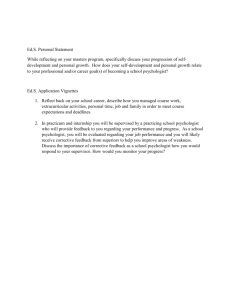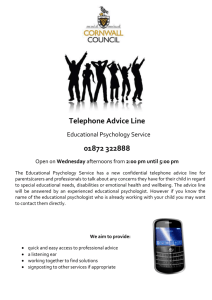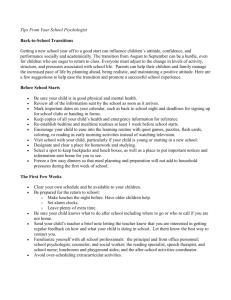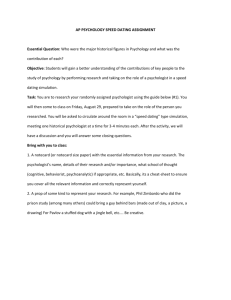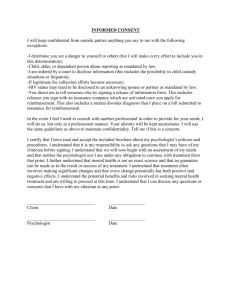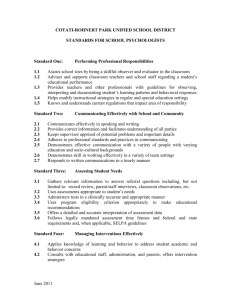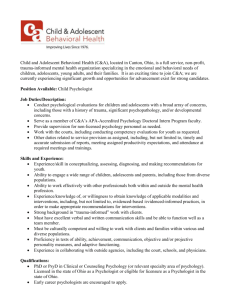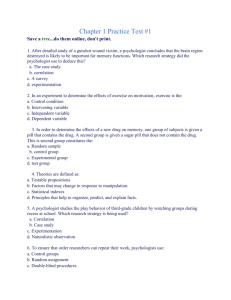AP Psychology
advertisement
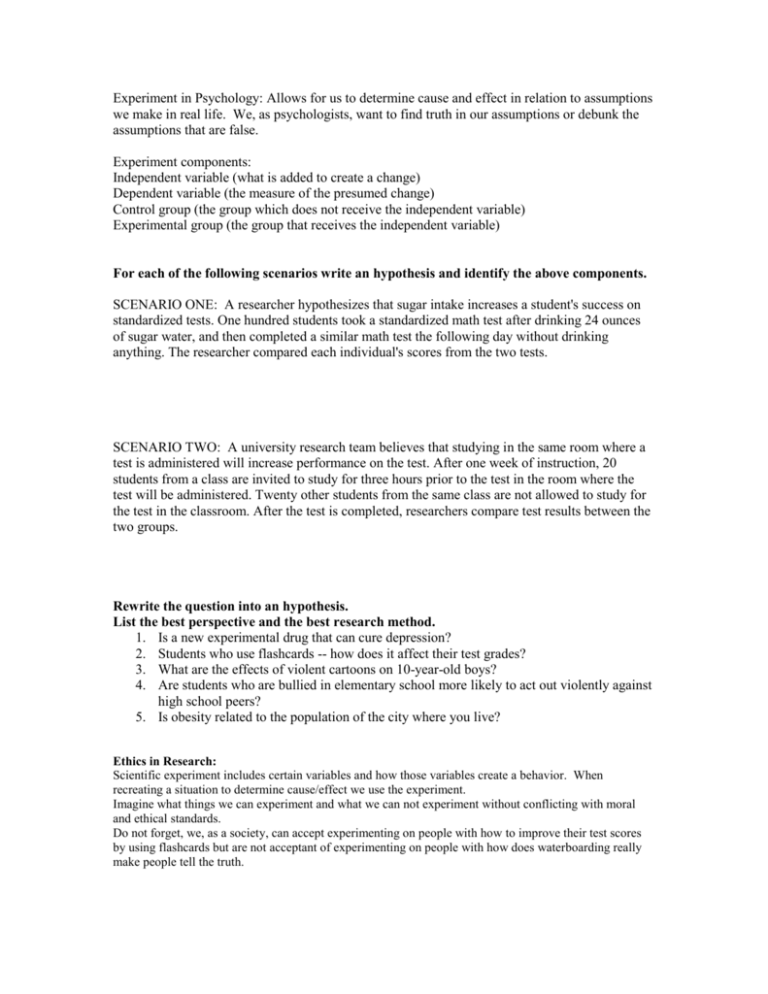
Experiment in Psychology: Allows for us to determine cause and effect in relation to assumptions we make in real life. We, as psychologists, want to find truth in our assumptions or debunk the assumptions that are false. Experiment components: Independent variable (what is added to create a change) Dependent variable (the measure of the presumed change) Control group (the group which does not receive the independent variable) Experimental group (the group that receives the independent variable) For each of the following scenarios write an hypothesis and identify the above components. SCENARIO ONE: A researcher hypothesizes that sugar intake increases a student's success on standardized tests. One hundred students took a standardized math test after drinking 24 ounces of sugar water, and then completed a similar math test the following day without drinking anything. The researcher compared each individual's scores from the two tests. SCENARIO TWO: A university research team believes that studying in the same room where a test is administered will increase performance on the test. After one week of instruction, 20 students from a class are invited to study for three hours prior to the test in the room where the test will be administered. Twenty other students from the same class are not allowed to study for the test in the classroom. After the test is completed, researchers compare test results between the two groups. Rewrite the question into an hypothesis. List the best perspective and the best research method. 1. Is a new experimental drug that can cure depression? 2. Students who use flashcards -- how does it affect their test grades? 3. What are the effects of violent cartoons on 10-year-old boys? 4. Are students who are bullied in elementary school more likely to act out violently against high school peers? 5. Is obesity related to the population of the city where you live? Ethics in Research: Scientific experiment includes certain variables and how those variables create a behavior. When recreating a situation to determine cause/effect we use the experiment. Imagine what things we can experiment and what we can not experiment without conflicting with moral and ethical standards. Do not forget, we, as a society, can accept experimenting on people with how to improve their test scores by using flashcards but are not acceptant of experimenting on people with how does waterboarding really make people tell the truth. AP Psychology Ms Stanford 1. Who would be most likely to agree with the statement, “Psychology should investigate only behaviors that can be observed”? a) Wilhelm Wundt b) Sigmund Freud c) William James d) Charles Darwin e) John Watson 2. Psychologists who study the degree to which genes influence out personality are working within the ________________ perspective. a) behavioral b) evolutionary c) behavior-genetics d) neuroscience e) cognitive 3. 4. Which psychological perspective emphasizes the interaction of the brain and body in behavior? a) neuroscience b) cognitive c) behavioral d) behavior-genetics e) evolutionary Two historical roots of psychology are: a) philosophy and chemistry b) physiology and chemistry c) philosophy and biology d) philosophy and physics e) biology and physics 5. Which of the following individuals is also a physician? a) clinical psychologist b) experimental psychologist c) hospital psychiatrist d) biological psychologist e) applied psychologist 6. Dr. Smith’s research centers on the relationship between changes in our thinking over the life span and changes in moral reasoning. Dr. Smith is most likely a: a) clinical psychologist b) personality psychologist c) psychiatrist d) developmental psychologist e) industrial psychologist Unit 1 Review 7. A major, general principle underlying the PRTR study method is that: a) people learn and remember material best when they actively process it b) many students overestimate their mastery of text and lecture material c) study time should be spaced over time rather than crammed into one session d) “overlearning” disrupts efficient retention e) hanging out at a frat party before studying creates the best success 8. After a detailed study of a gun-shot wound victim, a psychologist concludes that the brain region destroyed is likely to be important for memory functions. Which research strategy did the psychologist use to deduce this? a) the case study b) a survey c) experimentation d) correlation e) double-blinded study 9. In order to determine the effects of exercise on motivation, exercise is the: a) control condition b) intervening variable c) independent variable d) dependent variable e) experimenter bias 10. The scientific attitude of skepticism is based on the belief that: a) people are rarely candid in revealing their thoughts b) mental processes can’t be studied objectively c) the scientist’s intuition about behavior is usually correct d) ideas need to be tested against observable evidence e) people have little influence as to how their experiments are conducted 11. What is the mean for the following distribution of scores: 2, 3, 7, 6, 1, 4, 9, 5, 8, 2? a) 5 b) 4 c) 4.7 d) 3.7 e) 2 12. If shoes and IQ are negatively correlated, which of the following is true? a) people with large feet tend to have high IQs b) people with small feet tend to have high IQs c) people with small feet tend to have low IQs d) IQ is unpredictable based on a person’s shoe size e) None of the above 13. What is the median of the following distribution of scores: 1, 3, 7, 7, 2, 8, 4? a) 1 b) 2 c) 3 d) 4 e) 7 14. What is the mode of the following distribution of scores: 8, 2, 1, 1, 3, 7, 6, 2, 0, 2? a) 1 b) 2 c) 3 d) 4 e) 7 15. In generalizing from a sample to the population, it is important that: a) the sample is representative of the population b) the sample is large c) the scores in the sample have low variability d) all of the above e) none of the above 16. When a difference between two groups is “statistically significant,” this means that: a) the difference is statistically real but little of practical significance b) the difference is probably the result of sampling variation c) the difference is not likely to be due to chance variation d) all of the above e) none of the above 17. In an experiment to determine the effects of attention on memory, memory is the: a) control condition b) intervening variable c) independent variable d) dependent variable e) confounding variable 18. One reason researchers base their findings on representative samples is to avoid the false consensus effect, which refers to our tendency to: a) overestimate the extent to which others share our belief b) falsely perceive a relationship between two events when none exists c) underestimate errors in our judgment d) search of evidence to confirm our belief e) make all of the above reasoning errors 19. Which of the following best describes the hindsight bias? a) events seem more predictable before they have occurred b) events seem more predictable after they have occurred c) a person’s intuition is usually correct d) a person’s intuition is rarely correct e) none of the above 20. Which of the following is true, according to the text? a) because laboratory experiments are artificial, any principles discovered cannot be applied to everyday behaviors b) no psychological theory can be considered true until tested c) psychology’s theories reflect common sense d) psychology has few ties to other disciplines e) psychological experiments are most often tested using animals 21. Discuss three important principles in making generalizations about populations on the basis of samples. 22. Discuss the importance of random assignment and control techniques in research. 23. If your level of test anxiety goes down as your time spent studying for the exam goes up, would you say these events are positively or negatively correlated? Explain your reasoning. 24. Identify two pitfalls in thinking that make intuition and common sense untrustworthy. 25. Pick five of the seven perspectives and give an example of how they would explain love in an individual. 26. Explain the differences between a psychiatrist and a clinical psychologist.
